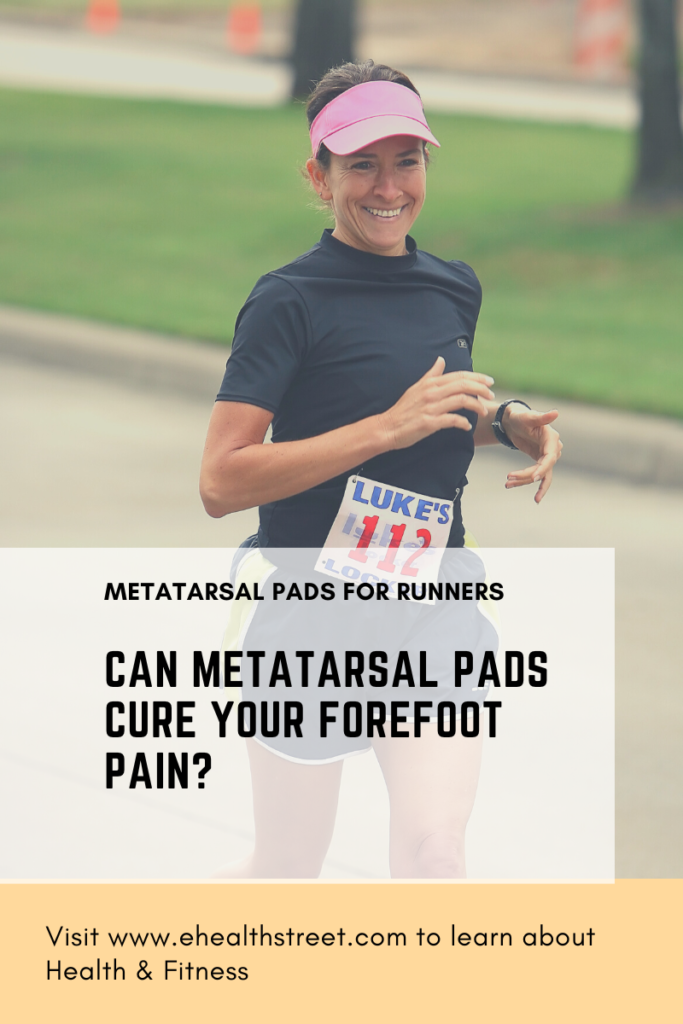Metatarsal pads are small cushions placed on the foot’s bottom, usually in the area of the metatarsal bones (the long bones in the middle of the foot).
These pads often provide extra cushioning and support for the foot, especially when walking or standing for long periods.
Metatarsal Pads for runners
Metatarsal pads can be helpful for runners who are experiencing pain or discomfort in the metatarsal area of the foot.
These pads can provide extra cushioning and support for the foot, which can help to alleviate pressure on the metatarsal bones and reduce pain or discomfort.
Pads can also help to distribute weight evenly across the foot, which can help to prevent other foot injuries such as plantar fasciitis (inflammation of the tissue on the bottom of the foot) or stress fractures.
It’s always a good idea to talk to a doctor or physical therapist before using metatarsal pads or any other type of foot orthotic. Make sure that they are appropriate for your specific needs and foot condition.

WHAT ARE THE BEST METATARSAL PADS FOR RUNNERS?
The best metatarsal pads for runners will depend on several factors, specific needs, and preferences of the individual runner.
Some runners may find that a gel-based metatarsal pad is the most comfortable and practical option, while others may prefer a foam or cushion-based pad. Runners must try different options to determine which type of metatarsal pad works best for them.
It’s essential to choose a high-quality pad designed specifically for running, as this will provide the best support and cushioning for the feet.
Effect of Metatarsal Pads and Their Positioning
Metatarsal pads are designed to provide cushioning and support for the metatarsal bones in the feet, which can help alleviate discomfort and pain in the feet.
The positioning of the metatarsal pads can affect their effectiveness in providing support and cushioning. For example, if the metatarsal pad is not placed correctly, it may not provide adequate support for the metatarsal bones.
The type of the pad and the materials it is made from can also impact its effectiveness. It is essential for individuals to try out different types of metatarsal pads and to position them to determine what works best for them.
Effect of Metatarsal Pads on Plantar Pressures
Metatarsal pads are cushioning devices that alleviate pain and discomfort in the forefoot, particularly in the metatarsal region.
These pads are designed to redistribute weight and reduce the pressure on the metatarsal bones, which can help to alleviate symptoms of conditions such as Metatarsalgia and Morton’s neuroma.
By reducing the pressure on the metatarsal bones, pads can help to reduce foot pain and improve overall foot function.
Effect of a Metatarsal Pad on the Forefoot During Gait
The forefoot bears significant weight and pressure during gait, and the metatarsal bones feel excessive anxiety and stress.
A pad can help distribute this weight and pressure more evenly across the forefoot, reducing stress and strain on the metatarsal bones.
It can help alleviate pain and discomfort in the forefoot and improve overall foot function and gait.
Can Metatarsal Pads Cure Your Forefoot Pain?
Metatarsal pads are used to treat forefoot pain but are not a cure—for various factors, including overuse, injury, or underlying medical conditions.
Pads can provide relief by cushioning the area and redistributing pressure, but they will not necessarily treat the underlying cause of the pain.
It’s essential to consult with a doctor or other healthcare provider to determine the cause of your forefoot pain and determine the best course of treatment.
What are the Medical Causes of Forefoot Pain?
Various factors, including overuse, injury, or underlying medical conditions, can cause forefoot pain. Some common medical causes of forefoot pain include:
- · Morton’s neuroma: a thickening of the tissue around a nerve in the forefoot, which can cause pain, tingling, and numbness
- · Metatarsalgia: pain and inflammation in the metatarsal bones in the forefoot
- · Plantar fasciitis: inflammation of the plantar fascia, a band of tissue that runs along the bottom of the foot
- · Bunions: a bony protrusion on the side of the big toe
- · Hammertoes: a condition in which the toes are bent at the middle joint, causing them to resemble a hammer
If you are experiencing forefoot pain, you must consult with a doctor or other healthcare provider to determine the cause and the best course of treatment.
How Met Pads Relieve Forefoot Pain
Metatarsal pads often treat forefoot pain by providing cushioning and support.
They are typically placed in the shoe under the metatarsal bones (the long bones in the forefoot) to redistribute pressure and alleviate pain.
By cushioning the area and distributing weight more evenly, metatarsal pads can help to reduce the pressure on the forefoot and alleviate pain.
In addition to providing cushioning, metatarsal pads can also help to correct foot
alignment and improve posture.
It can help to prevent further irritation and pain in the forefoot and may also help to treat the underlying cause of the pain.
It’s important to note that metatarsal pads are not a cure for forefoot pain. They
can provide relief, but they will not necessarily treat the underlying cause of
the pain.
It’s essential to consult with a doctor or other healthcare provider to determine the cause of your forefoot pain and determine the best course of treatment.
What Metatarsal Is Pad Material Best?
The best material for metatarsal pads will vary depending on the specific needs and preferences of the individual. Some common materials used in metatarsal pads include:
· Gel: Gel pads are soft and flexible and can provide a high level of cushioning and support. They are often preferred for their comfort and ability to conform to the foot’s shape.
· Foam: Foam pads are less expensive than gel pads and provide a moderate level of cushioning. They are a good option for individuals looking for a cost-effective solution to forefoot pain.
· Leather: Leather pads are more durable than gel or foam pads and can provide a high level of support. They are a good option for individuals who need a long-lasting, supportive pad.
It’s essential to try different materials and find the one that works best for you. It is also helpful to consult a doctor or other healthcare provider to select suitable metatarsal pad material.
What Is The Best Shape For Metatarsal Pads?
There is no one-size-fits-all answer to this question, as the best shape for metatarsal pads can vary depending on the individual’s foot shape and the specific condition being treated.
Pads are often contoured to match the foot’s shape and support the metatarsal bones. Some people may find that round or oval-shaped pads work best for them, while others may prefer places with a more contoured shape.
It is best to try out a few different shapes and sizes to see which one works best for you. It is also essential to consult with a podiatrist or other foot specialist to determine the best pad for your specific needs.
How Do Metatarsal Foot Pads Stay in Place?
Metatarsal foot pads are designed to stay in place by adhering to the bottom of the foot. Most metatarsal pads are made from materials with a sticky or adhesive backing, allowing them to stick to the foot and stay in place while walking or standing.
Some pads may also have additional features, such as straps or elastic bands, that help to secure them to the foot and keep them in place. In general, pads should stay in place as long as they are correctly positioned on the foot and the adhesive backing is still effective.
However, if a pad is not staying in place, it may be necessary to adjust it or try a different pad type. It is also a good idea to consult with a podiatrist or other foot specialist to ensure that the metatarsal pad is fitted correctly and provides the necessary support.
The Best Metatarsal Pads To Get Rid Of Forefoot Pain
The best metatarsal pads for relieving forefoot pain depend on the underlying cause and the individual’s foot shape and structure.
In general, pads are designed to provide support and cushioning for the metatarsal bones, which can help to relieve pain in the forefoot. Some common types of pads include gel pads, foam pads, and silicone pads.
Gel pads are often contoured to match the foot’s shape and provide a soft, cushioned surface for the metatarsal bones to rest on. Foam pads are also contoured to the foot and provide cushioning, but they may be firmer than gel pads.
Silicone pads are often more flexible and can be molded to fit the foot’s shape. It is essential to consult with a podiatrist or other foot specialist to determine the best metatarsal pad for your specific needs and condition.
WHY BUY FOOT PADS?
Foot pads are designed to provide cushioning and support for the feet, which can help alleviate discomfort and pain caused by activities such as standing, walking, or running for extended periods.
Foot pads can also help to distribute weight evenly across the foot, reducing the risk of developing foot problems such as plantar fasciitis or Metatarsalgia. Lastly, some foot pads are designed to provide arch support, which can benefit individuals with flat feet or high arches.
Overall, foot pads can help to improve foot health and comfort, making them a worthwhile investment for many people.
